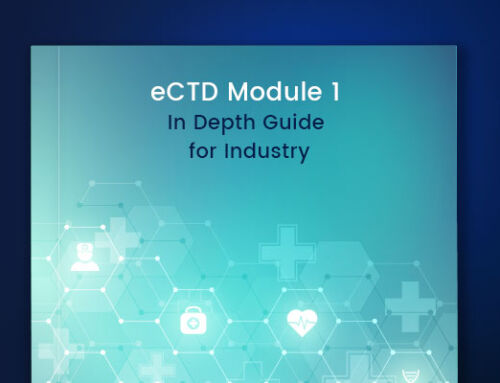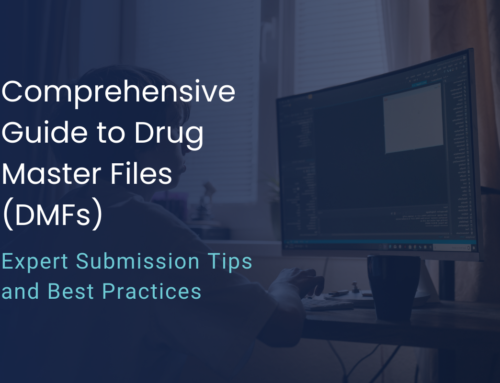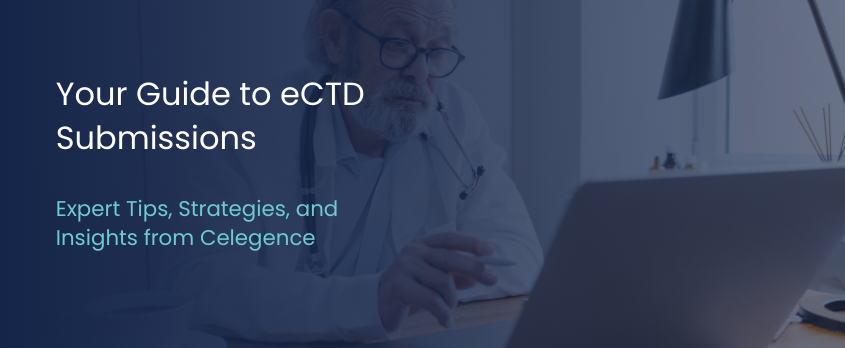
The Essential Guide to eCTD Submissions: Tips, Strategies and Key Insights
The electronic Common Technical Document (eCTD) is pivotal for regulatory submissions in the pharmaceutical industry. This digital format is essential for the organized submission of medical product information to regulatory authorities, helping to streamline the approval process. With eCTD becoming a standard requirement globally, effective management of these submissions is critical for maintaining compliance and achieving timely approval.
Efficient eCTD management requires both a comprehensive understanding of regulatory demands and a powerful, capable system to manage the submission intricacies. Celegence provides cutting-edge AI technology coupled with expert services to enhance the precision and speed of your eCTD submissions. Let’s explore how our advanced solutions can transform your regulatory submission process, keeping you competitive and compliant.
The basics of eCTD: Definition and Significance of eCTD
The electronic Common Technical Document (eCTD) is a standardized digital format for submitting medical product information to regulatory authorities. This format is essential for pharmaceutical companies aiming to obtain approval for new drugs and therapies. By using eCTD, companies ensure that their submission processes are aligned with international standards, which facilitates a quicker and more organized review by health authorities
Structure and Components of eCTD
eCTD is organized into five major modules:
- Module 1: Contains region-specific administrative and prescribing information.
- Module 2: Summarizes the overall submission with detailed reports on the quality, nonclinical study reports, and clinical study reports.
- Module 3: Dedicated to quality, it includes information on drug substance, drug product, intermediates, and materials used in the manufacturing process.
- Module 4: Includes nonclinical study reports, providing details on pharmacology and toxicology studies.
- Module 5: Contains clinical study reports, which cover clinical trial data and results.
Each module is critical, serving a distinct purpose that contributes to the comprehensive assessment of the pharmaceutical product by regulatory bodies.
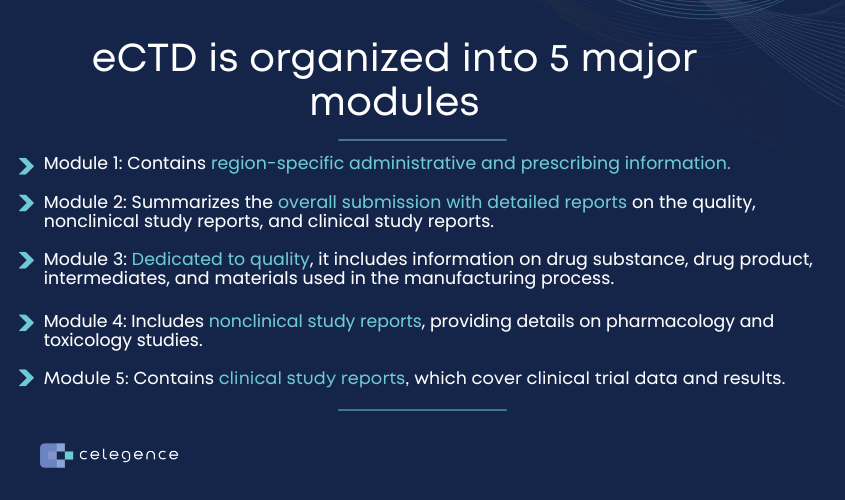
Brief History and Evolution of eCTD
The concept of the eCTD was developed in the late 1990s as part of an effort to harmonize the regulatory submission process across different regions, including the United States, Europe, and Japan. The format was designed to make the review process more efficient and to reduce the time and resources needed for drug approval. Over the years, the eCTD format has been adopted by an increasing number of countries, and its structure has been refined to accommodate evolving technological and regulatory requirements. The latest version, eCTD 4.0 (it is currently being outlined by the relevant regulatory authorities), offers enhancements that improve data integrity and submission efficiency.
Step-by-Step eCTD Submission Guide: Preparing for eCTD Submission
Preparing for an eCTD submission involves careful planning and meticulous document preparation. The key steps and essential documents required include:
- Document Collection: Gather all necessary documents such as clinical data, study reports, and manufacturing details.
- Formatting: Ensure all documents adhere to the ICH guidelines for eCTD. Documents must be in PDF format and appropriately bookmarked and hyperlinked.
- Validation: Use eCTD validation software to check for any technical errors that might be present in the submission package.
Walkthrough of the eCTD Submission Process
The eCTD submission process can be complex. Here’s a simplified walkthrough, enhanced with screenshots and diagrams:
- Step 1: Organize the documents according to the eCTD structure (Modules 1-5).
- Step 2: Compile the documents using eCTD management software, which helps assemble the dossier in the required format.
- Step 3: Validate the submission dossier with eCTD validation tools to ensure compliance with technical requirements.
- Step 4: Submit the dossier through the designated electronic portal, such as the FDA’s Electronic Submissions Gateway.
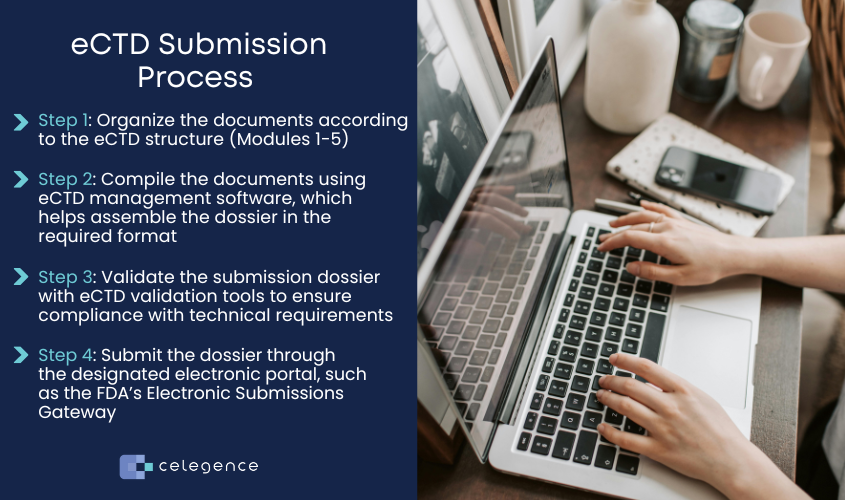
Tips for Ensuring Compliance
Ensuring compliance with regulatory standards is critical for successful eCTD submissions. Here are some tips:
- Regular Updates: Stay updated with the latest regulatory guidelines from relevant health authorities.
- Quality Checks: Implement multiple rounds of quality checks during the document preparation phase.
- Expert Review: Consider engaging with regulatory experts who can provide insights and identify potential issues before submission.
Troubleshooting Common Issues in eCTD Submissions: Common Pitfalls in eCTD Submissions and How to Avoid Them
Successfully submitting an eCTD involves treading through various challenges that can arise due to the complexity of regulatory requirements. Some common pitfalls include:
- Inconsistent Document Formatting: Ensure that all documents adhere to specified formats and are compatible with eCTD software.
- Navigation Errors in Hyperlinking and Bookmarking: Documents should have accurate bookmarks and hyperlinks to facilitate easy navigation for reviewers.
- Technical Validation Errors: Pre-empt validation issues by using reliable eCTD validation tools before submission.
Detailed Solutions to Typical Problems
Encountering problems during the submission process is common, but most are solvable with attention to detail:
- Problem: Incorrectly formatted documents.
- Solution: Use templates and checklists to ensure all documents meet the eCTD guidelines.
- Problem: Broken links and missing bookmarks.
- Solution: Implement a final review focused solely on navigation aids like hyperlinks and bookmarks.
- Problem: Technical rejections due to validation failures.
- Solution: Conduct multiple rounds of validation using updated software to catch errors before the actual submission.
Expert Advice on Maintaining Submission Integrity and Consistency
Maintaining the integrity and consistency of your eCTD submission is vital for regulatory approval. Here are some expert tips:
- Continuous Learning: Keep abreast of new regulations and software updates that can impact eCTD submissions.
- Quality Assurance: Establish a robust quality assurance process that includes peer reviews and pre-submission audits.
- Collaborative Efforts: Work closely with regulatory consultants and IT specialists to ensure that all aspects of the eCTD are compliant and optimized for submission.
eCTD Submission Software and Automation: Overview of Current Software Solutions
The market offers a variety of software solutions designed to facilitate eCTD submissions. These tools support the compilation, management, and submission of regulatory documentation in compliance with global standards. Common features include:
- Template-based Document Management: Assists in maintaining consistent formatting and organization.
- Automated Validation: Checks the submission for errors that could lead to rejection by regulatory authorities.
- Electronic Submission Gateways: Provides direct paths to submit documents to regulatory bodies such as the FDA or EMA.
Benefits of Using Automated Tools
Automated tools bring several benefits to the eCTD submission process, making them indispensable for regulatory affairs professionals:
- Increased Efficiency: Reduces the time required to prepare and submit documents.
- Reduced Error Rate: Minimizes manual errors through automated checks and balances.
- Enhanced Compliance: Ensures that all submissions meet the latest regulatory standards and guidelines.
Celegence’s AI-enabled Software and Its Advantages
Celegence leads the field with its innovative AI technology specifically designed for regulatory submission processes. Our AI-driven software accelerates the preparation, validation, and submission of eCTD documents, optimizing every phase to ensure compliance and efficiency. Key features include:
- Predictive Compliance: Uses AI to predict potential issues before they affect the submission, allowing for preemptive corrections.
- Integration Capabilities: Seamlessly integrates with existing systems, ensuring that transition to AI-enhanced processes is smooth and efficient.
- User-Friendly Interface: Designed for ease of use, reducing the learning curve and supporting effective management of regulatory documents.
- Automation of Repetitive Tasks: Automates routine tasks, freeing up valuable resources for more critical functions.
Celegence’s software not only simplifies the submission process but also empowers companies to maintain a competitive edge by ensuring faster, more reliable regulatory approvals.
How Celegence Helps with its AI-Enabled Software
Our AI technology has been instrumental in achieving significant operational efficiencies and on-time delivery rates for our clients:
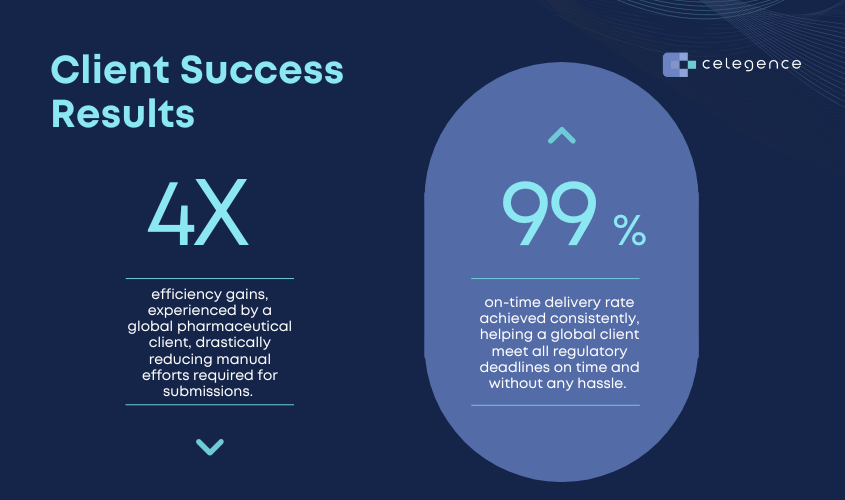
Celegence vis-a-vis its Competitors
When compared to other market offerings, Celegence’s software stands out due to its exceptional cost-effectiveness and superior quality metrics:
- Cost-Effectiveness: Our clients achieve more with less, enjoying more than 20% lower costs than with competing services.
- Quality Metrics: We maintain quality metrics above 95%, ensuring that submissions are not only timely but also of high quality.
By choosing Celegence, companies ensure they are equipped with the best tools to manage the regulatory requirements efficiently and successfully.
Industry Insights: The Growing Trend of AI in eCTD Submissions – Key Findings from the RAPS Survey
The Regulatory Affairs Professionals Society (RAPS) survey provides valuable insights into the adoption and impact of AI in the regulatory submission requirements. Key findings include:
- Adoption of AI: Nearly half of the survey respondents are currently using AI to automate their submission processes, with an equal number planning to do so in the future.
- Shift to eCTD v4.0: A significant 67% of leaders in the field are preparing submissions in the eCTD v4.0 format, with 60% assessing the transition to this newer version.
- Benefits Realized: More than half of the participants recognize the benefits of increased consistency and a 51% reduction in time and effort for submissions when using eCTD v4.0 compared to previous versions.
Industry Trends and Predictions
The integration of AI into eCTD submissions is shaping the future of regulatory practices. Here are some trends and predictions:
- Continued Growth of AI Adoption: As regulatory bodies update their submission requirements, the demand for AI-driven solutions will continue to rise, making these tools standard in the industry.
- Enhanced Accuracy and Efficiency: AI technologies are expected to improve the accuracy and efficiency of submissions, reducing the risk of non-compliance and delays.
- Expansion of AI Capabilities: Future advancements may introduce more sophisticated AI features, such as predictive analytics for regulatory outcomes and personalized automation strategies.
The shift towards AI automation and the planning of submissions in eCTD v4.0 are indicative of a broader transformation in the regulatory field, driven by technological advancements that enhance both compliance and operational efficiency.
Key Benefits of Partnering with Celegence
Partnering with Celegence brings a host of advantages to pharmaceutical companies navigating the complex regulatory requirements. Here are the key benefits:
- Cost-Effective Compliance: Minimize your regulatory expenses without compromising on compliance.
- First-Time Right Accuracy: Achieve accurate submissions on the first attempt, reducing the need for costly revisions.
- Quick Turnaround Times: Rapid response capabilities ensure that even the most urgent submissions are handled promptly and efficiently.
By choosing Celegence, you gain a reliable partner that not only meets but anticipates the needs of your regulatory strategies.
Partnering with Celegence brings a host of advantages to pharmaceutical companies navigating the complex regulatory requirements. Here are the key benefits:
- Cost-Effective Compliance: Minimize your regulatory expenses without compromising on compliance.
- First-Time Right Accuracy: Achieve accurate submissions on the first attempt, reducing the need for costly revisions.
- Quick Turnaround Times: Rapid response capabilities ensure that even the most urgent submissions are handled promptly and efficiently.
By choosing Celegence, you gain a reliable partner that not only meets but anticipates the needs of your regulatory strategies.
Effective management of the electronic Common Technical Document (eCTD) is crucial for pharmaceutical companies facing the stringent demands of regulatory submissions. The role of AI and modern technology in this domain cannot be overstated—they bring unprecedented precision, efficiency, and compliance to the regulatory processes. As the industry continues to evolve, leveraging these technological advancements will be key to maintaining a competitive edge and ensuring successful regulatory approvals.
Are you Ready to transform your eCTD submission process? Celegence, led by Sonia Veluchamy is more than a regulatory consulting firm. We are a strategic partner specializing in both medical devices and pharmaceutical submissions. Celegence is here to help with our expert solutions and advanced AI technology. Contact us or reach out to us at info@celegence.com to learn more about how our services can streamline your regulatory submissions, ensuring they are efficient, accurate, and compliant.
